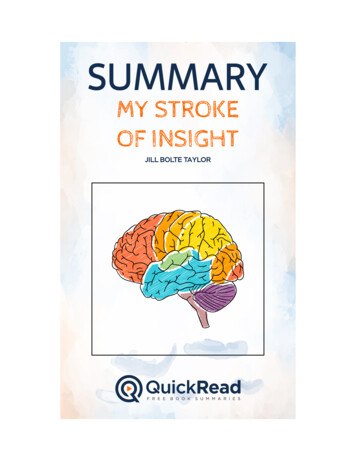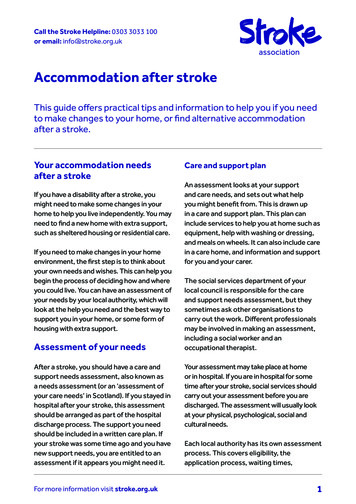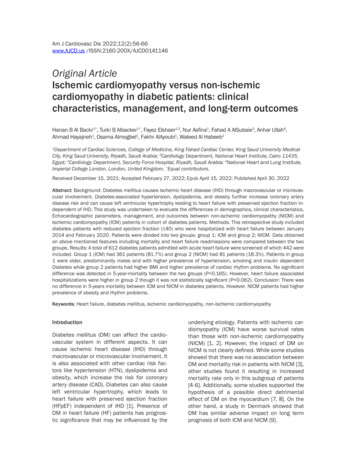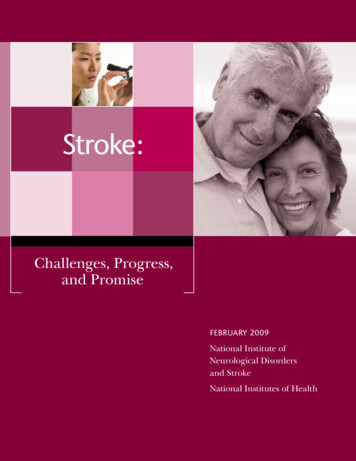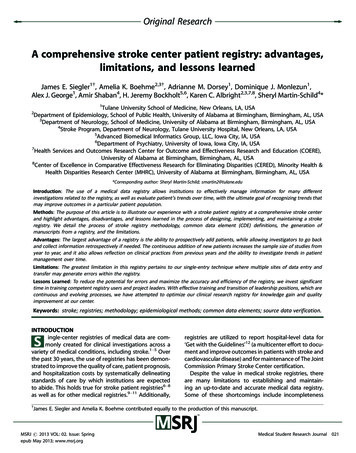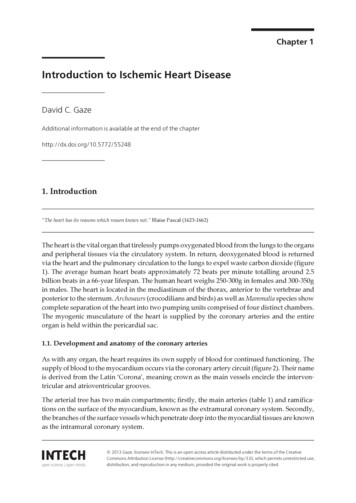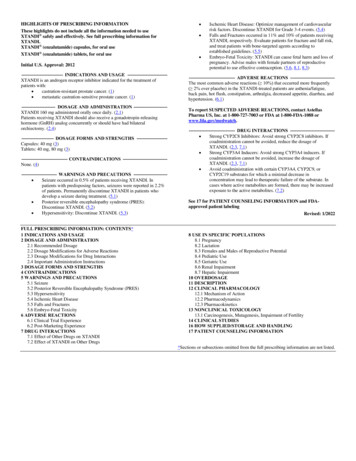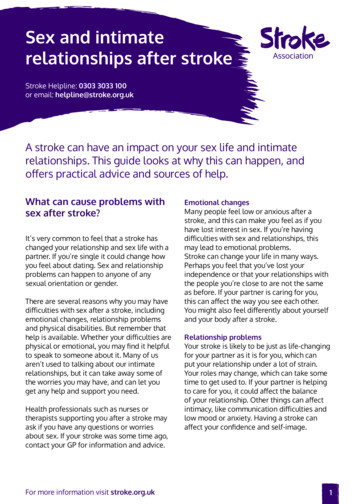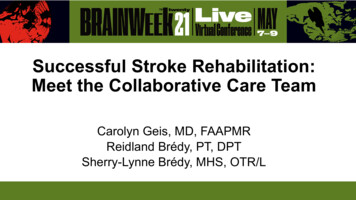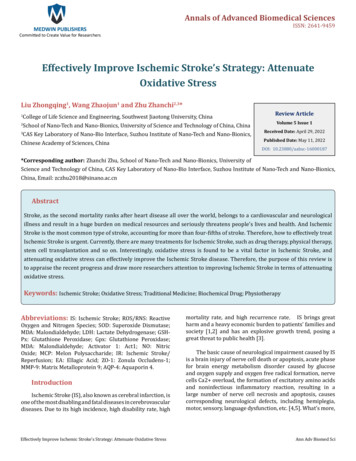
Transcription
Annals of Advanced Biomedical SciencesISSN: 2641-9459MEDWIN PUBLISHERSCommitted to Create Value for ResearchersEffectively Improve Ischemic Stroke’s Strategy: AttenuateOxidative StressLiu Zhongqing1, Wang Zhaojun1 and Zhu Zhanchi2,3*College of Life Science and Engineering, Southwest Jiaotong University, China2School of Nano-Tech and Nano-Bionics, University of Science and Technology of China, China3CAS Key Laboratory of Nano-Bio Interface, Suzhou Institute of Nano-Tech and Nano-Bionics,Chinese Academy of Sciences, China1Review ArticleVolume 5 Issue 1Received Date: April 29, 2022Published Date: May 11, 2022DOI: 10.23880/aabsc-16000187*Corresponding author: Zhanchi Zhu, School of Nano-Tech and Nano-Bionics, University ofScience and Technology of China, CAS Key Laboratory of Nano-Bio Interface, Suzhou Institute of Nano-Tech and Nano-Bionics,China, Email: zczhu2018@sinano.ac.cnAbstractStroke, as the second mortality ranks after heart disease all over the world, belongs to a cardiovascular and neurologicalillness and result in a huge burden on medical resources and seriously threatens people’s lives and health. And IschemicStroke is the most common type of stroke, accounting for more than four-fifths of stroke. Therefore, how to effectively treatIschemic Stroke is urgent. Currently, there are many treatments for Ischemic Stroke, such as drug therapy, physical therapy,stem cell transplantation and so on. Interestingly, oxidative stress is found to be a vital factor in Ischemic Stroke, andattenuating oxidative stress can effectively improve the Ischemic Stroke disease. Therefore, the purpose of this review isto appraise the recent progress and draw more researchers attention to improving Ischemic Stroke in terms of attenuatingoxidative stress.Keywords: Ischemic Stroke; Oxidative Stress; Traditional Medicine; Biochemical Drug; PhysiotherapyAbbreviations: IS: Ischemic Stroke; ROS/RNS: ReactiveOxygen and Nitrogen Species; SOD: Superoxide Dismutase;MDA: Malondialdehyde; LDH: Lactate Dehydrogenase; GSHPx: Glutathione Peroxidase; Gpx: Glutathione Peroxidase;MDA: Malondialdehyde; Activator 1: Act1; NO: NitricOxide; MCP: Melon Polysaccharide; IR: Ischemic Stroke/Reperfusion; EA: Ellagic Acid; ZO-1: Zonula Occludens-1;MMP-9: Matrix Metalloprotein 9; AQP-4: Aquaporin 4.IntroductionIschemic Stroke (IS), also known as cerebral infarction, isone of the most disabling and fatal diseases in cerebrovasculardiseases. Due to its high incidence, high disability rate, highEffectively Improve Ischemic Stroke’s Strategy: Attenuate Oxidative Stressmortality rate, and high recurrence rate, IS brings greatharm and a heavy economic burden to patients’ families andsociety [1,2] and has an explosive growth trend, posing agreat threat to public health [3].The basic cause of neurological impairment caused by ISis a brain injury of nerve cell death or apoptosis, acute phasefor brain energy metabolism disorder caused by glucoseand oxygen supply and oxygen free radical formation, nervecells Ca2 overload, the formation of excitatory amino acidsand noninfectious inflammatory reaction, resulting in alarge number of nerve cell necrosis and apoptosis, causescorresponding neurological defects, including hemiplegia,motor, sensory, language dysfunction, etc. [4,5]. What’s more,Ann Adv Biomed Sci
2Annals of Advanced Biomedical Sciencescerebral embolism induced by nerve damage or vascularblockage caused by hypoxia is the leading cause of IS, andoxidative stress, inflammatory, and blood-brain barrierfailure play a huge role in this process [6].The antioxidant effect of monomeric Chinese medicinecomponents has recently been the subject of a growingnumber of studies. Polyphenols [12] reduce mitochondrialoxidative stress by suppressing oxidative enzymes,superoxide generation, and oxidatively modified lowdensity lipoprotein (OxLDL) synthesis while also enhancingantioxidant enzymes. Quercetin [13], for example, decreasesdamage by upregulating antioxidant enzymes, poly(ADP-ribose) polymerase (PARP), and caspase-3 activityexpression, as well as lowering MDA levels. Furthermore, acid,base and salt monomers lessen oxidative stress. Through theIL-6/ STAT3 pathway, oleic acid [14] lowers MDA and ROSlevels while increasing SOD and CAT expression. Throughthe Nrf2 pathway, chlorogenic acid [15] boosted SOD activityand GSH levels while lowering ROS and LDH generation andMDA build up. Rhodizone [16] decreased ROS generation bylowering total SOD and SOD2 activity. To reduce brain injuryin MCAO rats, ephedrine [17] increases GPx and CAT activity,lowers MDA and NO levels, and promotes phosphorylation ofPI3K and AKT proteins by stimulating the Erk/CREB/eNOSpathway [18].A large number of studies have shown that oxidativestress caused by ROS/RNS can cause nerve cell damage [7]and further lead to a cellular inflammatory, implying thatoxidative stress may be the primary cause of IS and targetingoxidative stress is critical for IS treatment [8]. Meanwhile,antioxidant research mainly focuses on traditional medicine,biochemical medicines, physical therapy and so on. Therefore,we will review the use of these antioxidants in attenuatingoxidative stress in IS.Oxidative stressOxidative stress occurs when the body’s oxidation andantioxidation systems are out of balance, resulting in cellularoverproduction of reactive oxygen and nitrogen species(ROS/RNS) that aren’t removed by antioxidant processes,and it’s associated with aging and disease development. ROSincludes superoxide (O2-), hydrogen peroxide (H2O2), andhydroxide radicals (OH-), while RNS includes nitric oxide(NO), nitrogen dioxide (NO2), and peritonitis, to name a few(ONOO-). Different oxidases for the synthesis of oxygen freeradicals, such as Nicotine adenine dinucleotide phosphate(NADP), oxidase (NOX), and xanthine oxidase (XO), arerecognized as biomarkers for the treatment of cerebralischemia by anti-oxidative [9]. Copper-zinc SOD (SOD1) inthe cytoplasm, manganese SOD (SOD2) in the mitochondria,and superoxide dismutase (SOD) in the nucleus are allrequired for the conversion of O2 to H2O2. Catalase (CAT)and glutathione enzyme (GSH) are engaged in hydrogenperoxide hydrolysis, with glutathione enzymes such asGlutathione reductase (GR), glutathione peroxidase (GSHPx), peroxidase (POD), besides, its biomarkers also includemalondialdehyde (MDA) and lactate dehydrogenase (LDH).Traditional MedicineTraditional medicine, which literally means “classicalformula,” is a type of medicine that has been passed downfrom ancient times to the present day in China. Accordingto the report, Coix seeds decreases oxidative stress byactivating the TGF/ALK1 signaling pathway, reducing MDA,and increasing superoxide dismutase SOD and GSH whencompared to the ischemic stroke/reperfusion (IR) group, GSHand SOD have been shown to protect the brain from ischemia[10]. When compared to the IR group, the Metformin groupreduced oxidative stress damage by changing lncRNA-H19and boosting Rock 2 expression, which reduced MDA, NO,and activated GSH-Px [11].Glycosides, compounds formed by linking the end groupcarbon atom of a sugar or sugar derivative to another class ofnon-sugar substances. Among, Forsythiaside A [19] causes asignificant augment in the expression levels of Nrf2, NAD(P)H, and glutathione transferase, decreasing the expression ofmalondialdehyde and enhances the expression of superoxidedismutase and glutathione. Pinoresinol diglucoside [20]reduces NO, ROS, and MDA levels and significantly increasesSOD, GSH, and GSH-Px by modulating NF-κB pathway andNrf2/HO-1 pathway. In addition, other analogues suchas bitter melon polysaccharide (MCP) [21], it had directscavenging effects on NO, O2(-) and ONOO- and inhibits lipidperoxidation by inhibiting the activation of JNK3/C-jun/Fas-L and JNK3/cytochrome C/caspase-3 signal cascades toattenuate oxidative stress.And we also made many of works to clarify the mechanismof alleviation of IR damage, ellagic acid (EA) treats IR, TTC(2,3,5-triphenyltetrazolium chloride staining) shows that itcan reduce the infarct area, infarct areas were stained white(Figure 1 A). It is obvious that EA degrades the expressionof MMP-9, AQP-4 and upgrades ZO-1 by western blotessay (Figure 1 B). In addition, the level of oxidative stressmarkers MDA and SOD also is changed and samples wererespectively taken from serum and brain (Figure 1C and D),which indicate that EA alleviates the brain damage by antioxidative response, it can restore the dysfunction of brainblood barrier (BBB). These results shows that anti-oxidativecan reduce IR damage and oxidative stress play crucial rolesin ischemic stroke.Zhu Zhanchi, et al. Effectively Improve Ischemic Stroke’s Strategy: Attenuate Oxidative Stress.Ann Adv Biomed Sci 2022, 5(1): 000187.Copyright Zhu Zhanchi, et al.
Annals of Advanced Biomedical Sciences3Biochemical DrugFigure 1: Effects of EA on cerebral ischemia model in rats [22].Biochemical drugs are mainly classified into nucleicacids, proteins, enzymes, lipids, etc., due to their conveniencedrug delivery, operability, and strong editability, they occupya pivotal position in basic scientific research. With theadvent of the post-genomic era, the structure and functionof DNA, amino acids, peptides, and proteins have beencomprehensively cognized. This chapter address non-codingNcRNAsLncRNABiomarkersOIP5-AS1LncRNA NKILALncRNA R-153-3p MDA SOD、GSH-Px MAD、NO SOD、GSH-Px MAD、NO SOD、GSH-Px MAD NAD(P)H、HO-1 ROSRNAs [23], a class of genetic, epigenetic, and translationalregulatory factors, which is composed of microRNAs(miRNAs), long non-coding RNAs (lncRNAs), and circRNAs(circRNAs). Due to the development of deep sequencingtechnology, Non-coding RNAs transcriptions were identified,and their role in disease mechanism is increasingly clear. Thefollowing Table 1 summarizes non-coding RNAs regulatingIR by influencing oxidative stress (experimental groupversus the IR group).Pathway(s)Reference(s)via sponging miR-186-5p negativeregulation to CTRP3 by inhibitingthe NF-κB and activating the Nrf2pathwayChen, et al. [24]bound to miR-421 to facilitate XIAPexpressionKang, et al. [26]Inhibit NF-κBInhibit PKD1 and JAK/STAT3inhibit SRC-mediated MAPK ROS、MDA MDA、ROSZhu Zhanchi, et al. Effectively Improve Ischemic Stroke’s Strategy: Attenuate Oxidative Stress.Ann Adv Biomed Sci 2022, 5(1): 000187.suppress the IRAK1/TRAF6/TAK1/NF-κBenhance thephosphorylation ofERK/JNK/MAPKGao, et al. [25]Li, et al. [27]Yu, et al. [28]Tian, et al. [29]Li, et al. [30]Copyright Zhu Zhanchi, et al.
Annals of Advanced Biomedical Sciences4miR-193b-3p SODmiR-217 MDA、ROSmiR-410 SOD、GSH-PxmiR-340-5pmiR-424the seven in absentia homolog 1/JunN-terminal kinaseYang, et al. [31]Downregulate Act1/NF-κBLi, et al. [33]miR-217/MEF2D/HDAC5,miR-217/MEF2D/ND6 SODinhibit of the TIMP2-dependentMAPK pathway MDA、LDH SOD2Table 1: Emerging ncRNAs on oxidative stress regulating ischemic stroke.PhysiotherapyAcupuncture originated from Taoism and Confucianismhas the highest recognition and dissemination. A large numberof randomized controlled experiments have confirmedthe clinical efficacy of acupuncture and moxibustion, andsome technologies can systematically evaluate the effect ofacupuncture and moxibustion on brain treatment [36]. Atthe same time, Acupuncture also shows the effect of antioxidative stress for IS. Jittiwat found that Laser Acupuncture[37] can reduce the activities of MDA and SOD, and improvethe expression of CAT and GSH-Px to alleviate the injury of IS.There are also teams exploring new physical methods, suchas Extremely Low-Frequency Electromagnetic field (ELFEMF), to improve antioxidant capacity through activation ofLDH and SOD [38].ConclusionCurrently, when many free radicals are produced, themain strategy of antioxidant stress process is to makevarious measures to promote free radical degradationand inhibit the production of free radicals. Physiotherapy,a non-invasive measure, mainly can reduce free radicalsvia inhibiting oxidation generation. However, a repeatedexperiment cannot be realized because of the complexinternal environment. Moreover, the specific molecularmechanism of physiotherapy is difficult to explain and stillunclear. Many clinical trials show that traditional Chinesemedicine can alleviate IS injury and improve the patient’scondition, which mainly through promoting the generationof antioxidant enzymes and free radical degradation. Butit’s difficult to guarantee the dosage of administration andutilization rate. Nucleic acid drugs have clear targets andstrong editability, which are the main means of target mining.However, when nucleic acid drugs enter the physical complexmicroenvironment, their degradation rate is significant. Atpresent, nanomaterials that targeted modification have beenfrequently reported as drug delivery carriers, which has asmall size, convenient delivery ways and sustained releaseShi, et al. [32]Liu, et al. [34]Liu, et al. [35]function. And it may be a “rising star” for the antioxidantprotection of IS. As above, the main regulating chemicalstress pathways include activating the classic ERK pathwayor inhibiting the NF-κB Pathway. Excessive oxidative stresscan produce ROS/RNS, which not only leads to the deathof nerve cells but also causes inflammation. In conclusion,oxidative stress plays a vital role in the treatment of IS. Itis desirable for us to further explore antioxidant drugs andclarify their mechanisms, which will bring an expectation topatients with cerebral ischemia.Conflicts of Interest: Authors declare no conflict ofinterest.References1.2.3.4.5.6.Xu ZY, Xu Y, Xie XF, Tian Y, Sui JH, et al. (2021) Antiplatelet aggregation of Panax notoginseng triol saponinsby regulating GP1BA for ischemic stroke therapy. ChinMed 16(1): 12.Hasan TF, Hasan H, Kelley RE (2021) Overview ofacute ischemic stroke evaluation and management.Biomedicines 9(10): 1486.Hankey GJ (2014) Secondary stroke prevention. LancetNeurol 13(2): 178-194.Cao B, Tan F, Zhan J, Lai PH (2021) Mechanism underlyingtreatment of ischemic stroke using acupuncture:transmission and regulation. Neural Regen Res 16(5):944-954.Orellana Urzúa S, Claps G, Rodrigo R (2021) Improvementof a Novel Proposal for Antioxidant Treatment AgainstBrain Damage Occurring in Ischemic Stroke Patients.CNS Neurol Disord Drug Targets 20(1): 3-21.Moskowitz MA, EH Lo, Iadecola C (2010) The scienceof stroke: mechanisms in search of treatments. Neuron67(2): 181-198.Zhu Zhanchi, et al. Effectively Improve Ischemic Stroke’s Strategy: Attenuate Oxidative Stress.Ann Adv Biomed Sci 2022, 5(1): 000187.Copyright Zhu Zhanchi, et al.
Annals of Advanced Biomedical Sciences57.8.9.Datta A, Sarmah D, Mounica L, Kaur H, Kesharwani R, etal. (2020) Cell Death Pathways in Ischemic Stroke andTargeted Pharmacotherapy. Transl Stroke Res 11(6):1185-1202.Forman, HJ, Zhang H (2021) Targeting oxidative stress indisease: promise and limitations of antioxidant therapy.Nat Rev Drug Discov 20(9): 689-709.Allen CL, Bayraktutan U, (2009) Oxidative stress and itsrole in the pathogenesis of ischaemic stroke. Int J Stroke4(6): 461-470.10. Bazmandegan G, Boroushaki MT, Shamsizadeh A,Ayoobi F, Hakimizadeh E, et al. (2017) Brown propolisattenuates cerebral ischemia-induced oxidative damagevia affecting antioxidant enzyme system in mice. BiomedPharmacother 85: 503-510.11. Zeng J, Zhu L, Liu J, Zhu T, Xie Z, et al. (2019) MetforminProtects against Oxidative Stress Injury Inducedby Ischemia/Reperfusion via Regulation of thelncRNA-H19/miR-148a-3p/Rock2 Axis. Oxid Med CellLongev 16: 8768327.12. Cheng YC, Sheen JM, Hu WL, Hung YC (2017) Polyphenolsand Oxidative Stress in Atherosclerosis-Related IschemicHeart Disease and Stroke. Oxid Med Cell Longev 2017:8526438.13. Ahmad A, Khan MM, Hoda MN, Raza SS, Khan MB, etal. (2011) Quercetin protects against oxidative stressassociated damages in a rat model of transient focalcerebral ischemia and reperfusion. Neurochem Res36(8): 1360-1371.14. Aliena Valero A, Rius Pérez S, Baixauli Martín J, TorregrosaG, Chamorro A, et al. (2021) Uric Acid NeuroprotectionAssociated to IL-6/STAT3 Signaling Pathway Activationin Rat Ischemic Stroke. Mol Neurobiol 58(1): 408-423.15. Liu D, Wang H, Zhang Y, Zhang Z (2020) Protective Effectsof Chlorogenic Acid on Cerebral Ischemia/ReperfusionInjury Rats by Regulating Oxidative Stress-Related Nrf2Pathway. Drug Des Devel Ther 14: 51-60.16. Zhao Y, Huang Y, Fang Y, Zhao H, Shi W, et al. (2018)Chrysophanol attenuates nitrosative/oxidative stressinjury in a mouse model of focal cerebral ischemia/reperfusion. J Pharmacol Sci 138(1): 16-22.17. Huang L, Zhao B, Li Q, Wu J, Jiang H, et al. (2021)Ephedrine alleviates middle cerebral artery occlusioninduced neurological deficits and hippocampal neuronaldamage in rats by activating PI3K/AKT signalingpathway. Bioengineered 12(1): 4136-4149.18. Li Y, Zhang X, Ma A, Kang Y (2021) Rational Applicationof β-Hydroxybutyrate Attenuates Ischemic Strokeby Suppressing Oxidative Stress and MitochondrialDependent Apoptosis via Activation of the Erk/CREB/eNOS Pathway. ACS Chem Neurosci 12(7): 1219-1227.19. Ma, T, Shi YL, Wang YL (2019) Forsythiaside A protectsagainst focal cerebral ischemic injury by mediating theactivation of the Nrf2 and endoplasmic reticulum stresspathways. Mol Med Rep 20(2): 1313-1320.20. Zhang Y, Lei Y, Yao X, Yi J, Feng G (2021) Pinoresinoldiglucoside alleviates ischemia/reperfusion-inducedbrain injury by modulating neuroinflammation andoxidative stress. Chem Biol Drug Des 98(6): 986-996.21. Gong J, Sun F, Li Y, Zhou X, Duan Z, et al. (2015)Momordica charantia polysaccharides could protectagainst cerebral ischemia/reperfusion injury throughinhibiting oxidative stress mediated c-Jun N-terminalkinase 3 signaling pathway. Neuropharmacology 91:123-34.22. Wang Y, Wu Y, Liang C, Tan R, Tan L, et al. (2019)Pharmacodynamic Effect of Ellagic Acid on AmelioratingCerebral Ischemia/Reperfusion Injury. Pharmacology104(5-6): 320-331.23. Matsui M, Corey DR (2017) Non-coding RNAs as drugtargets. Nat Rev Drug Discov 16(3): 167-179.24. Chen Y, Liu W, Chen M, Sun Q, Chen H, et al. (2021) Upregulating lncRNA OIP5-AS1 protects neuron injuryagainst cerebral hypoxia-ischemia induced inflammationand oxidative stress in microglia/macrophage throughactivating CTRP3 via sponging miR-186-5p. IntImmunopharmacol 92: 107339.25. Gao W, Ning Y, Peng Y, Tang X, Zhong S, et al. (2021)LncRNA NKILA relieves astrocyte inflammation andneuronal oxidative stress after cerebral ischemia/reperfusion by inhibiting the NF-κB pathway. MolImmunol 139: 32-41.26. Kang M, Ji F, Sun X, Liu H, Zhang C (2021) LncRNASNHG15 Promotes Oxidative Stress Damage to Regulatethe Occurrence and Development of Cerebral Ischemia/Reperfusion Injury by Targeting the miR-141/SIRT1Axis. J Healthc Eng 2021: 6577799.27. Li J, Lv H, Che YQ (2020) Upregulated microRNA-31inhibits oxidative stress-induced neuronal injurythrough the JAK/STAT3 pathway by binding to PKD1 inmice with ischemic stroke. J Cell Physiol 235(3): 24142428.Zhu Zhanchi, et al. Effectively Improve Ischemic Stroke’s Strategy: Attenuate Oxidative Stress.Ann Adv Biomed Sci 2022, 5(1): 000187.Copyright Zhu Zhanchi, et al.
628. Yu S, Zhai J, Yu J, Yang Q, Yang J (2021) miR-98-5pprotects against cerebral ischemia/reperfusion injurythrough anti-apoptosis and anti-oxidative stress in mice.J Biochem 169(2): 195-206.29. Tian R, Wu B, Fu C, Guo K (2020) miR-137 preventsinflammatory response, oxidative stress, neuronal injuryand cognitive impairment via blockade of Src-mediatedMAPK signaling pathway in ischemic stroke. Aging(Albany NY) 12(11): 10873-10895.30. Li Y, Peng B, Li Y, Huang A, Peng Y, et al. (2022) MiR-203a3p/153-3p improves cognitive impairments induced byischemia/reperfusion via blockade of SRC-mediatedMAPK signaling pathway in ischemic stroke. Chem BiolInteract 358: 109900.31. Yang T, Wu J, Ge K, Wang F, Fan J, et al. (2022) MicroRNA193b-3p reduces oxidative stress and mitochondrialdamage in rats with cerebral ischemia-reperfusion injuryvia the seven in absentia homolog 1/Jun N-terminalkinase pathway. Bioengineered 13(3): 6942-6954.32. Shi L, Tian Z, Fu Q, Li H, Zhang L, et al. (2020) miR217-regulated MEF2D-HDAC5/ND6 signaling pathwayparticipates in the oxidative stress and inflammatoryresponse after cerebral ischemia. Brain Res 1739:146835.33. Li D, Zhou J, Yang B, Yu Y (2019) microRNA-340-5pAnnals of Advanced Biomedical Sciencesinhibits hypoxia/reoxygenation-induced apoptosisand oxidative stress in cardiomyocytes by regulatingthe Act1/NF-kappaB pathway. J Cell Biochem 120(9):14618-14627.34. Liu, N N, ZL Dong, Han LL (2018) MicroRNA-410inhibition of the TIMP2-dependent MAPK pathwayconfers neuroprotection against oxidative stressinduced apoptosis after ischemic stroke in mice. BrainRes Bull 143: 45-57.35. Liu P, Zhao H, Wang R, Wang P, Tao Z, et al. (2015)MicroRNA-424 protects against focal cerebral ischemiaand reperfusion injury in mice by suppressing oxidativestress. Stroke 46(2): 513-519.36. Kaptchuk TJ (2002) Acupuncture: theory, efficacy, andpractice. Ann Intern Med 136(5): 374-383.37. Jittiwat J (2017) Laser Acupuncture at GV20 ImprovesBrain Damage and Oxidative Stress in Animal Model ofFocal Ischemic Stroke. J Acupunct Meridian Stud 10(5):324-330.38. Cichoń N, Bijak M, Miller E, Saluk J (2017) Extremelylow frequency electromagnetic field (ELF-EMF)reduces oxidative stress and improves functionaland psychological status in ischemic stroke patients.Bioelectromagnetics 38(5): 386-396.Zhu Zhanchi, et al. Effectively Improve Ischemic Stroke’s Strategy: Attenuate Oxidative Stress.Ann Adv Biomed Sci 2022, 5(1): 000187.Copyright Zhu Zhanchi, et al.
illness and result in a huge burden on medical resources and seriously threatens people's lives and health. And Ischemic . PI3K and AKT proteins by stimulating the Erk/CREB/eNOS pathway [18]. Glycosides, compounds formed by linking the end group . following Table 1 summarizes non-coding RNAs regulating IR by influencing oxidative stress .
